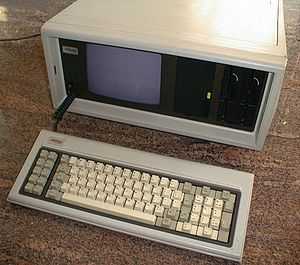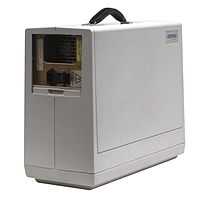Compaq Portable
|
A Compaq Portable with the keyboard detached ready for use | |
| Manufacturer | Compaq Computer Corporation |
|---|---|
| Product family | Compaq Portable series |
| Type | Portable computer |
| Release date | January 1983 |
| Introductory price | US$3,590 |
| Operating system | MS-DOS |
| Memory | 128 kilobytes (expandable to 640 KiB) |
| Storage | Two 5.25" floppy disk drives or, optionally, one floppy drive and a 10 MB hard drive |
| Display | Built-in 9" green screen monitor |
| Graphics | Unique CGA-compatible video card |
| Weight | 28 lb (13 kg) |
| Backward compatibility | IBM PC compatible |
| Successor | Compaq Portable Plus |
The Compaq Portable was an early portable computer which was one of the first 100% IBM PC compatible systems. It was Compaq Computer Corporation's first product, to be followed by others in the Compaq portable series and later Compaq Deskpro series. Compaq derived their company name from the phrase "Compatibility and Quality".
Production
Announced in November 1982 and first shipped in January 1983 priced at US $2,995 (equivalent to $7,100 in 2015) with a single half-height 5¼" 360 kB diskette drive or $3,590 for dual diskette drives, this "luggable" suitcase-sized computer was an early all-in-one computer, becoming available two years after the CP/M-based Osborne 1 and Kaypro II, in the same year as the MS-DOS-based (but not entirely IBM PC compatible) Dynalogic Hyperion and a year before the Commodore SX-64. Its design was influenced by that of the Xerox NoteTaker, a prototype computer developed at Xerox PARC in 1976. The 28 lb (13 kg)[1] Compaq Portable folded up into a luggable case the size of a portable sewing machine.
Compaq sold 53,000 units in the first year and set revenue records for American businesses in its first three years of operation.
Design
Hardware
The Compaq Portable had basically the same hardware as an IBM PC, transplanted into a luggable case, with Compaq's custom BIOS instead of IBM's. Compaq ignored the 64k, single-sided floppy, and cassette-only models of the IBM PC and all Portables shipped with 128k of RAM and 1-2 double-sided disk drives. The machine used a unique hybrid of the IBM MDA and CGA which supported the latter's graphics modes, but contained both cards' text fonts in ROM.[1] When using the internal monochrome monitor, the 9x14 font was used and the 8x8 one when an external monitor was used (the user switched between internal and external monitors by pressing Ctrl+Alt->). With a larger external monitor, this graphics hardware was also used in the original Compaq Deskpro desktop computer. Thus the user got the advantages of both IBM video standards (graphics capabilities plus high-resolution text.
| Various views | ||||||||
|---|---|---|---|---|---|---|---|---|
|
Software
Compaq's efforts were possible because IBM had used mostly off-the-shelf parts for the PC and published full technical documentation for it, and because Microsoft had kept the right to license MS-DOS to other computer manufacturers. The only hurdle was the BIOS because of containing IBM's copyrighted code. Compaq solved this problem by producing a clean room workalike that performed all documented functions of the IBM PC BIOS, but was completely written from scratch. Although numerous other companies soon followed its lead into the market for PC compatibles, few matched Compaq's remarkable achievement of essentially-complete software compatibility with the IBM PC (typically reaching "95% compatibility" at best) until Phoenix Technologies and others began selling similarly reverse-engineered BIOSs on the open market.[2] IBM initially attempted to sue Compaq for copyright infringement, but the upstart company was prepared for this and the lawsuit was soon dismissed. Thus, the way was paved for any company to produce its own PC clone.
The first Portables used Compaq DOS 1.13, essentially identical to PC DOS 1.10 except for having a standalone BASIC that did not require the IBM PC's ROM Cassette BASIC, but this was superseded in a few months by DOS 2.00 which added hard disk support and other advanced features.
Aside from using DOS 1.x, the initial Portables were similar to the 16k-64k models of the IBM PC in that the BIOS was limited to 544k of RAM and did not support expansion ROMs, thus making them unable to use EGA/VGA cards, hard disks, or similar hardware. After DOS 2.x and the IBM XT came out, Compaq quickly upgraded the BIOS to match them. Although the Portable was not offered with a factory hard disk, users commonly installed them.
Reception
Byte wrote, after testing a prototype, that the Compaq Portable "looks like a sure winner" because of its portability, cost, and high degree of compatibility with the IBM PC. Its reviewer tested IBM PC DOS, CP/M 86, WordStar, Supercalc, and several other software packages, and found that all worked except one game.[1] PC Magazine also rated the Compaq Portable very highly for compatibility, reporting that all tested applications ran. It praised the "rugged" hardware design and sharp display, and concluded that it was "certainly worth consideration by anyone seeking to run IBM PC software without an IBM PC".[3]
Successors
This machine was the first of a series of Compaq Portable machines including the Portable Plus, Portable 286, Portable II, Portable III, Portable 386, Portable 486 and Portable 486c.
See also
- IBM Portable
References
- ↑ 1.0 1.1 1.2 Dahmke, Mark (January 1983). "The Compaq Portable". BYTE. pp. 30–36. Retrieved 27 July 2013.
- ↑ Alsop, Stewart (1994-01-31). "A public Windows pane to make compatibility clearer". InfoWorld. p. 102. Retrieved February 28, 2011.
- ↑ Sandler, Corey (June 1983). "Compaq: Have Computer Will Travel". PC Magazine. p. 186. Retrieved 21 October 2013.
External links
| Wikimedia Commons has media related to Compaq Portable. |




